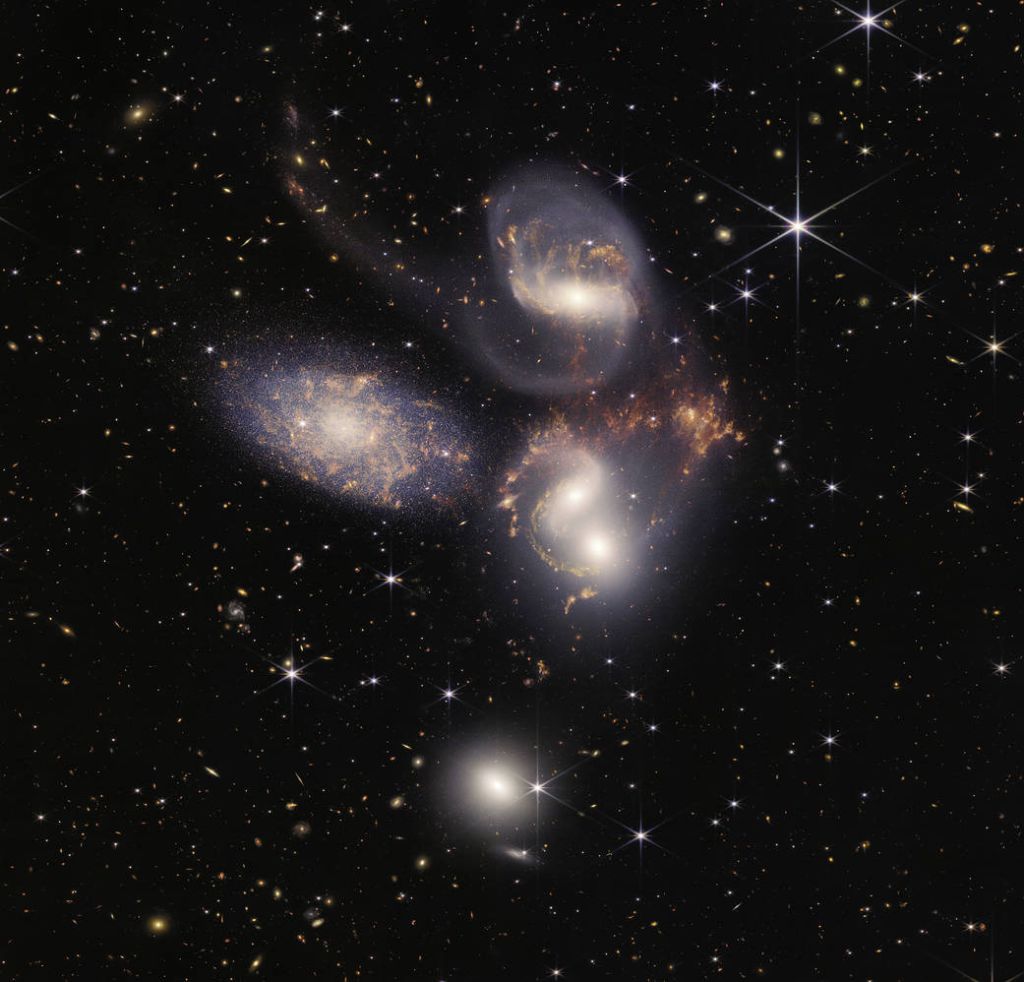
James Webb telescope shows how shock wave size of Milky Way changes environment around cluster of galaxies
Collisions of galaxies generate giant shock waves which lead to many interesting phenomena, up to and including the formation of stars and new galaxies. The brightest such object in the universe has become the group of five galaxies of Stephan's Quintet, which appeared not by chance in one of the first photographs by the James Webb Space Telescope. Unique processes take place in this group of galaxies, which can tell a lot about the evolution of stars and galaxies.
According to space.com, only four galaxies in the Stephan's Quintet group of galaxies are in close interaction. One of them, the NGC 7318b, flew into this group at about 800 km/s. The collision of the interstellar gas cloud surrounding the galaxy with another galaxy and the gas cloud of the entire group has created a shock wave and created various types of cosmic-level turbulence.
Three domains of detailed study of interstellar gas turbulence. Photo credit: ALMA, M. Weiss.
Inferences can be made about the rotations and flows of interstellar gas, mainly molecular hydrogen, based on the James Webb telescope's infrared observations. Information about the behavior of cold molecular hydrogen was obtained thanks to radio observations. These particular studies were supplemented by data provided by the ALMA radio telescope complex. Combining the actual James Webb and ALMA databases has shed light on processes that raise more questions than they answer.
Turbulence caused by the propagation of the shock wave front tore off the old gas films, which led to the formation of regions where hydrogen began to actively participate in star formation processes.
Stephan's Quintet group of galaxies.
In one of the study areas, for example, scientists have observed protostellar disks and expect a new dwarf galaxy to form in this area. In other parts, completely incomprehensible processes are observed, during which the interstellar gas went through many cycles of heating and cooling. This phenomenon still remains unclear and will require new observations.
The James Webb Space Telescope is equipped with spectrometers and, as Space.com notes, it will be able to provide a more complete picture of the processes taking place in the Stephan's Quintet. Spectra of heated hydrogen will give data about its movement velocities and vectors. This third component of object observations will provide details that, if not fully, will reveal much of the physics of these phenomena and enable further refinement of models of stellar and galaxy evolution.
- Related News
- 11 incredible satellite photos published on Earth Day
- NASA shows all of Ingenuity's flight trajectories in one video
- Could life exist on Saturn's moon Enceladus?
- Why is it so difficult to send people to the Moon today?
- Once in a lifetime phenomenon: This year we will observe a star explosion that occurred 3,000 years ago
- "AMADEE-24" Mars Analog Research Mission in Armash came to an end
- Most read
month
week
day
- Pavel Durov gives interview to Tucker Carlson: From 3-hour interview, less than hour appears in final version 1405
- Meta unveils Llama 3 and claims it's the "most powerful" open source language model 833
- Once in a lifetime phenomenon: This year we will observe a star explosion that occurred 3,000 years ago 821
- WhatsApp to integrate AI function: What will it do? 778
- Nokia and Heineken introduce Boring Phone: It does not have social networks and a browser, but it is designed for people over 21 (photo) 770
- Google fires 28 employees who protested against company's cooperation with Israel 769
- Boston Dynamics introduces new version of Atlas robot that is completely electric։ Where will it be applied? 739
- iPhone 17 Plus will have smaller screen 705
- 5 best smartphones with IPS screens 692
- How often is it worth replacing a smartphone with a new one? 660
- Archive
